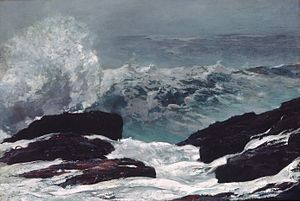
Winslow Homer was an American landscape painter and illustrator, best known for his marine subjects. He is considered one of the foremost painters in 19th-century America and a preeminent figure in American art.

Andrew Newell Wyeth was an American visual artist, primarily a realist painter, working predominantly in a regionalist style. He believed he was also an abstractionist, portraying subjects in a new, meaningful way. The son of N. C. Wyeth and father of Jamie Wyeth, he was one of the best-known U.S. artists of the middle 20th century. James H. Duff explores the art and lives of the three men in An American Vision: Three Generations of Wyeth Art. Raised with an appreciation of nature, Wyeth took walks that fired his imagination. Henry David Thoreau, Robert Frost, and King Vidor's The Big Parade (1925) inspired him intellectually and artistically. Wyeth featured in a documentary The Metaphor in which he discussed Vidor's influence on the creation of his works of art, like Winter 1946 and Portrait of Ralph Kline. Wyeth was also inspired by Winslow Homer and Renaissance artists.
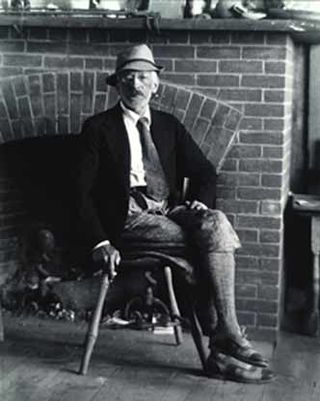
Charles Herbert Woodbury, was an American marine painter.

Joan Whitney Payson was an American heiress, businesswoman, philanthropist, patron of the arts and art collector, and a member of the prominent Whitney family. She was also co-founder and majority owner of Major League Baseball's New York Mets baseball franchise, and was the first woman to own a major league team in North America without inheriting it.

The Butler Institute of American Art, located on Wick Avenue in Youngstown, Ohio, United States, was the first museum dedicated exclusively to American art. Established by local industrialist and philanthropist Joseph G. Butler, Jr., the museum has been operating pro bono since 1919. Dedicated in 1919, the original structure is a McKim, Mead and White work listed on the National Register of Historic Places.

The Portland Museum of Art, or PMA, is the largest and oldest public art institution in the U.S. state of Maine. Founded as the Portland Society of Art in 1882. It is located in the downtown area known as The Arts District in Portland, Maine.

The Gulf Stream is an 1899 oil painting by Winslow Homer. It shows a man in a small dismasted rudderless fishing boat struggling against the waves of the sea, and was the artist's statement on a theme that had interested him for more than a decade. Homer vacationed often in Florida, Cuba, and the Caribbean.
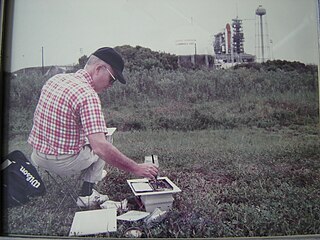
Philip Jamison was an American artist working primarily with watercolor as a medium. Typical scenes are landscapes, seascapes, interiors and flower arrangements.
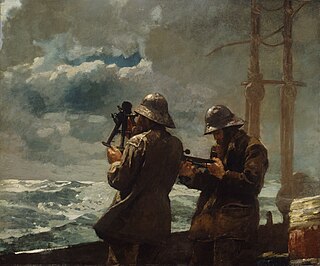
Eight Bells is an 1886 oil painting by the American artist Winslow Homer. It depicts two sailors determining their ship's latitude. It is one of Homer's best-known paintings and the last of his major paintings of the 1880s that dramatically chronicle man's relationship to the ocean.

Abraham Jacob Bogdanove was an American artist, mural painter, and teacher best known for his seascape paintings of the Maine coast, particularly around Monhegan Island.
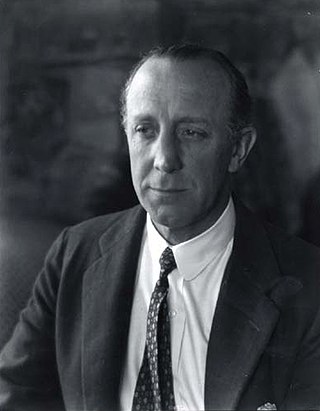
Paul Hampden Dougherty was an American marine painter. Dougherty was recognized for his American Impressionism paintings of the coasts of Maine and Cornwall in the years after the turn of the 20th century. His work has been described as bold and masculine, and he was best known for his many paintings of breakers crashing against rocky coasts and mountain landscapes. Dougherty also painted still lifes, created prints and sculpted.

John Currie Wilmerding Jr., is an American professor of art, collector, and curator, and is best known as a prolific author of books on American art.

Snap the Whip is an 1872 oil painting by Winslow Homer. It depicts a group of children playing crack the whip in a field in front of a small red schoolhouse. With more of America's population moving to cities, the portrait depicts the simplicity of rural agrarian life that Americans were beginning to leave behind in the post-Civil War era, evoking a mood of nostalgia.

The Fog Warning is one of several paintings on marine subjects by the late-19th-century American painter Winslow Homer (1836–1910). Together with The Herring Net and Breezing Up, painted the same year and also depicting the hard lives of fishermen in Maine, it is considered among his best works on such topics.
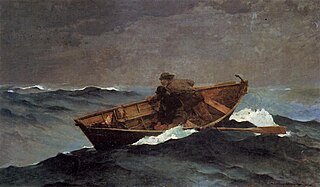
Lost on the Grand Banks (1885) is one of several paintings on marine subjects by the American painter Winslow Homer (1836–1910). Together with The Herring Net and The Fog Warning, painted in the same year, it depicts the hard lives of North Atlantic fishermen in Prouts Neck, Maine. The painting was bought in 1998 by Bill Gates, the then chairman of Microsoft, who reportedly paid $30 million for the seascape, at the time a record price for an American painting.
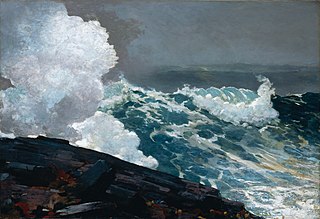
Northeaster is one of several paintings on marine subjects by the late-19th-century American painter Winslow Homer. Like The Fog Warning and Breezing Up, he created it during his time in Maine. It is on display in the Metropolitan Museum of Art in New York. Viewers are presented a struggle of elements between the sea and the rocky shore. Winslow Homer excelled in painting landscape paintings that depicted seascapes and mountain scenery.

Cannon Rock is an 1895 oil painting by Winslow Homer. It is part of the Metropolitan Museum of Art's collection.

Searchlight on Harbor Entrance, Santiago de Cuba is an early 20th century painting by American artist Winslow Homer. It is currently (2018) in the collection of the Metropolitan Museum of Art.

Moonlight, Wood Island Light is a late 19th-century oil painting by American artist Winslow Homer. The painting is currently in the collection of the Metropolitan Museum of Art in New York.

The Veteran in a New Field is an oil-on-canvas painting by the 19th-century American artist Winslow Homer. It is set in the aftermath of the American Civil War and is often interpreted as an emblem of postbellum American society. The painting depicts a farmer harvesting wheat in a field with a scythe. The farmer in the painting is identified as a former Union Soldier from his discarded jacket and canteen in the right foreground of the painting. This painting was one of several that Homer did on the American Civil War, including his previous works Home, Sweet Home and Prisoners from the Front. The Veteran in a New Field is a transitional painting in Homer's body of work. It comments on the postbellum return of soldiers to daily life and the history of death that they bring along with them. It uses biblical themes to comment on war and nature, while also alluding to stories from classical history.
